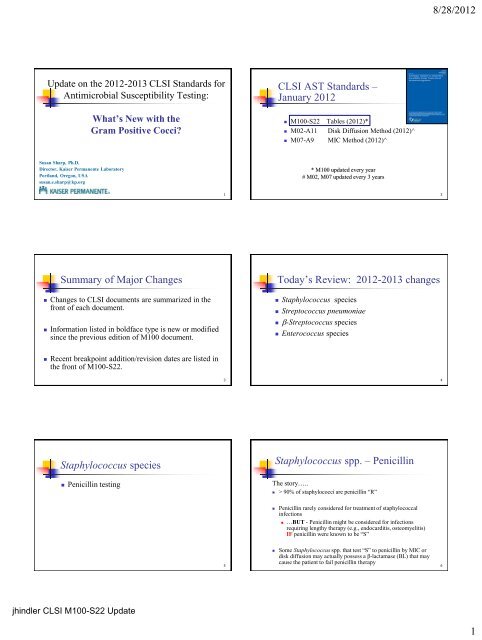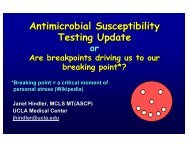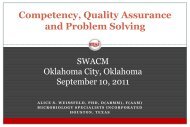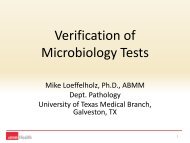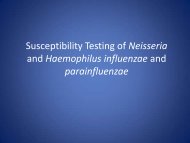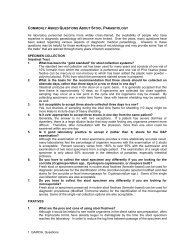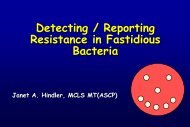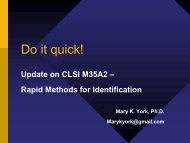Update on the 2012-2013 CLSI Standards for Antimicrobial - SWACM
Update on the 2012-2013 CLSI Standards for Antimicrobial - SWACM
Update on the 2012-2013 CLSI Standards for Antimicrobial - SWACM
Create successful ePaper yourself
Turn your PDF publications into a flip-book with our unique Google optimized e-Paper software.
8/28/<strong>2012</strong><br />
<str<strong>on</strong>g>Update</str<strong>on</strong>g> <strong>on</strong> <strong>the</strong> <strong>2012</strong>-<strong>2013</strong> <strong>CLSI</strong> <strong>Standards</strong> <strong>for</strong><br />
<strong>Antimicrobial</strong> Susceptibility Testing:<br />
What’s New with <strong>the</strong><br />
Gram Positive Cocci<br />
<strong>CLSI</strong> AST <strong>Standards</strong> –<br />
January <strong>2012</strong><br />
• M100-S22 Tables (<strong>2012</strong>)*<br />
• M02-A11 Disk Diffusi<strong>on</strong> Method (<strong>2012</strong>)^<br />
• M07-A9 MIC Method (<strong>2012</strong>)^<br />
Susan Sharp, Ph.D.<br />
Director, Kaiser Permanente Laboratory<br />
Portland, Oreg<strong>on</strong>, USA<br />
susan.e.sharp@kp.org<br />
* M100 updated every year<br />
# M02, M07 updated every 3 years<br />
1<br />
2<br />
Summary of Major Changes<br />
• Changes to <strong>CLSI</strong> documents are summarized in <strong>the</strong><br />
fr<strong>on</strong>t of each document.<br />
• In<strong>for</strong>mati<strong>on</strong> listed in boldface type is new or modified<br />
since <strong>the</strong> previous editi<strong>on</strong> of M100 document.<br />
Today’s Review: <strong>2012</strong>-<strong>2013</strong> changes<br />
• Staphylococcus species<br />
• Streptococcus pneum<strong>on</strong>iae<br />
• b-Streptococcus species<br />
• Enterococcus species<br />
• Recent breakpoint additi<strong>on</strong>/revisi<strong>on</strong> dates are listed in<br />
<strong>the</strong> fr<strong>on</strong>t of M100-S22.<br />
3<br />
4<br />
Staphylococcus species<br />
• Penicillin testing<br />
Staphylococcus spp. – Penicillin<br />
The story…..<br />
• > 90% of staphylococci are penicillin “R”<br />
• Penicillin rarely c<strong>on</strong>sidered <strong>for</strong> treatment of staphylococcal<br />
infecti<strong>on</strong>s<br />
• …BUT - Penicillin might be c<strong>on</strong>sidered <strong>for</strong> infecti<strong>on</strong>s<br />
requiring lengthy <strong>the</strong>rapy (e.g., endocarditis, osteomyelitis)<br />
IF penicillin were known to be “S”<br />
5<br />
• Some Staphylococcus spp. that test “S” to penicillin by MIC or<br />
disk diffusi<strong>on</strong> may actually possess a β-lactamase (BL) that may<br />
cause <strong>the</strong> patient to fail penicillin <strong>the</strong>rapy<br />
6<br />
jhindler <strong>CLSI</strong> M100-S22 <str<strong>on</strong>g>Update</str<strong>on</strong>g><br />
1
8/28/<strong>2012</strong><br />
Staphylococcus spp. – Penicillin<br />
Induced ß-lactamase (BL) Test<br />
• <strong>CLSI</strong> Previous recommendati<strong>on</strong>:<br />
• Per<strong>for</strong>m induced nitrocefin BL test be<strong>for</strong>e reporting<br />
penicillin as “S” if:<br />
• z<strong>on</strong>e diameter ≥29 mm<br />
• MIC ≤0.12 µg/ml<br />
• PCR <strong>for</strong> <strong>the</strong> blaZ β-lactamase gene may be c<strong>on</strong>sidered<br />
Penicillin Breakpoints<br />
-Sub isolate to blood agar<br />
-Inducti<strong>on</strong>: Drop disk to induce BL<br />
producti<strong>on</strong> (e.g., oxacillin or cefoxitin)<br />
-Incubate overnight<br />
MIC (µg/ml)<br />
Z<strong>on</strong>e (mm)<br />
S I R S I R<br />
≤0.12 - ≥0.25 ≥29 - ≤28<br />
-Test cells from periphery of z<strong>on</strong>e<br />
-If BL positive, report penicillin R<br />
Pos<br />
Neg<br />
Reference: M100-S21. Table 2C. Page 70<br />
7<br />
8<br />
Staphylococcus aureus<br />
β-lactamase (BL)<br />
• Induced nitrocefin BL test usually, but not always, detects<br />
staphylococcal BL<br />
• O<strong>the</strong>r BL tests are more sensitive <strong>for</strong> BL:<br />
• Cloverleaf test<br />
• Penicillin disk z<strong>on</strong>e edge test<br />
• blaZ gene PCR not optimal <strong>for</strong> BL<br />
• blaZ codes <strong>for</strong> BL producti<strong>on</strong><br />
• Several types of blaZ genes<br />
Staphylococcus aureus<br />
β-lactamase (BL) Study<br />
• 348 MSSA (low penicillin MICs) characterized <strong>for</strong> blaZ by PCR:<br />
• 303 PCR negative<br />
• 45 PCR positive<br />
• Methods:<br />
• Penicillin MICs<br />
• Phenotypic BL tests<br />
• Nitrocefin - Cefinase<br />
• Nitrocefin - Dryslide<br />
• Cloverleaf assay<br />
• Penicillin disk z<strong>on</strong>e edge<br />
9<br />
*Statens Serum Institut (Denmark), CDC (Atlanta), MGH (Bost<strong>on</strong>)<br />
10<br />
Staphylococcus aureus<br />
BL Study<br />
• 1 blaZ neg and penicillin “R”<br />
• 23 blaZ pos and penicillin “S”<br />
S<br />
R<br />
Pen MIC<br />
(µg/ml)<br />
blaZ functi<strong>on</strong>al<br />
Neg<br />
0.008 2<br />
0.016 15<br />
Pos<br />
0.032 180 1<br />
0.06 90 5<br />
0.12 15 17<br />
0.25 1 14<br />
0.5 4<br />
1.0<br />
Cloverleaf Assay <strong>for</strong><br />
β-lactamase +<br />
S. aureus<br />
• 5% sheep blood agar<br />
• S. aureus ATCC 25923 as <strong>the</strong><br />
indicator BL+ organism<br />
• 1 unit penicillin disk<br />
• Negative (penicillin-S) strain<br />
BL negative<br />
D<br />
C<br />
A<br />
B<br />
Reference: <strong>CLSI</strong> Agenda Book January 2011.<br />
2.0 2<br />
4.0 1<br />
303 45<br />
• Some difficulties reading<br />
Reference: <strong>CLSI</strong> Agenda Book January 2011.<br />
Isolates A-D are all<br />
BL positive<br />
12<br />
jhindler <strong>CLSI</strong> M100-S22 <str<strong>on</strong>g>Update</str<strong>on</strong>g><br />
2
8/28/<strong>2012</strong><br />
Staphylococcus aureus<br />
Disk Z<strong>on</strong>e Edge Test (10 U penicillin disk and standard disk diffusi<strong>on</strong> method)<br />
β-lactamase<br />
positive<br />
β-lactamase<br />
negative<br />
Fuzzy / “beach” =<br />
β-lactamase negative,<br />
Penicillin - S<br />
S. aureus QC:<br />
Neg - ATCC 25923<br />
Sharp / “cliff” =<br />
β-lactamase positive,<br />
Penicillin - R<br />
Pos - ATCC 29213<br />
(supplemental QC)<br />
13<br />
Reference: M100-S22. Table 2C Supplemental Table 1. Page 83<br />
14<br />
Staphylococcus aureus<br />
3 Lab BL Study Results (N=348)<br />
Staphylococcus aureus<br />
Penicillin (MIC ≤0.12 µg/ml) Reporting<br />
Test Sensitivity Specificity<br />
Cefinase 77% 100%<br />
Dryslide 88% 100%<br />
Penicillin MIC ≤0.12 µg/ml<br />
A<br />
Nitrocefin β-lactamase<br />
positive<br />
B<br />
A<br />
Nitrocefin β-lactamase<br />
negative<br />
Note: If doing disk<br />
diffusi<strong>on</strong> routinely, just<br />
examine z<strong>on</strong>e edge <strong>for</strong><br />
those with z<strong>on</strong>e sizes<br />
of > 29mm.<br />
Cloverleaf 100% 100%<br />
Penicillin disk z<strong>on</strong>e edge 96% 100%<br />
Report penicillin “R”<br />
Per<strong>for</strong>m penicillin disk z<strong>on</strong>e-edge test<br />
≥ 29 mm fuzzy<br />
Report penicillin “S”<br />
≥ 29 mm sharp<br />
Report penicillin “R”<br />
Reference: <strong>CLSI</strong> Agenda Book January, 2011<br />
15<br />
M100-S22. Table 2C Supplemental Table 1. Page 80<br />
16<br />
Staphylococcus spp. – Penicillin<br />
Staphylococcus spp. –<br />
Penicillin Opti<strong>on</strong>al Strategy<br />
• NEW RECOMMENDATION:<br />
• Added ‘penicillin disk z<strong>on</strong>e edge test’ <strong>for</strong> BL<br />
producti<strong>on</strong> in S. aureus<br />
• Report penicillin if “R”<br />
• Suppress penicillin if “S” and add note “C<strong>on</strong>tact laboratory<br />
if penicillin results needed”<br />
• If penicillin “S” and penicillin results needed, per<strong>for</strong>m:<br />
• S. aureus<br />
• Nitrocefin BL test , and if negative<br />
• Penicillin z<strong>on</strong>e edge test<br />
17<br />
18<br />
jhindler <strong>CLSI</strong> M100-S22 <str<strong>on</strong>g>Update</str<strong>on</strong>g><br />
3
8/28/<strong>2012</strong><br />
Acti<strong>on</strong> Items<br />
Staphylococcus<br />
S. aureus<br />
• Isolates where penicillin z<strong>on</strong>es are ≥29 mm or penicillin MICs are ≤0.12<br />
µg/ml, per<strong>for</strong>m a penicillin ‘disk z<strong>on</strong>e edge test’ be<strong>for</strong>e reporting as<br />
penicillin susceptible.<br />
• NOTE:<br />
• S.lugdunensis isolates where penicillin z<strong>on</strong>es are ≥29 mm or penicillin MICs are<br />
≤0.12 µg/ml, per<strong>for</strong>m an induced nitrocefin assay or o<strong>the</strong>r <strong>CLSI</strong> reference method <strong>on</strong><br />
isolates be<strong>for</strong>e reporting as penicillin susceptible.<br />
• The penicillin disk z<strong>on</strong>e edge test was shown to be inferior as compared to <strong>the</strong><br />
induced nitrocefin assay and should not be used with S.lugdunensis.<br />
• Oxacillin – Intermediate<br />
• Table 2C / Note (13)<br />
• If oxacillin-I results (disk diffusi<strong>on</strong> testing) are<br />
obtained <strong>for</strong> S.aureus, per<strong>for</strong>m testing <strong>for</strong> mecA or<br />
PBP 2a, <strong>the</strong> cefoxitin MIC or cefoxitin disk test, an<br />
oxacillin MIC test, or <strong>the</strong> oxacillin-salt agar screening<br />
test. Report <strong>the</strong> result of <strong>the</strong> alternative test ra<strong>the</strong>r<br />
than <strong>the</strong> oxacillin-I result.<br />
19<br />
20<br />
Staphylococcus<br />
• Oxacillin – Resistance<br />
• Table 2C / Note (12)<br />
• If oxacillin-R staphylococci report penicillin as resistant<br />
or do not report.<br />
Staphylococcus<br />
• Disks per plate – clarificati<strong>on</strong><br />
• 12 disks <strong>on</strong>ly <strong>on</strong> a 150mm plate<br />
• 5 disks <strong>on</strong>ly <strong>on</strong> a 100mm plate<br />
• Do not measure z<strong>on</strong>e of inhibiti<strong>on</strong> of hemolysis<br />
21<br />
22<br />
Enterococcus – Vancomycin (4/32)<br />
• For isolates with MICs of 8-16 mg/ml<br />
• Per<strong>for</strong>m tests are listed in 2D-Supplemental Table 1<br />
• 2D-Supplemental Table 1<br />
• Motility<br />
• Pigment<br />
• E.gallinarum (n<strong>on</strong>-pigmented, motility +)<br />
• E.casseliflavus (pigmented yellow, motility +)<br />
• O<strong>the</strong>r Enterococcus (n<strong>on</strong>-pigmented, n<strong>on</strong>-motile)<br />
23<br />
Enterococcus - Vancomycin<br />
• Alternative inoculum method provided <strong>for</strong><br />
vancomycin resistance screen test<br />
• 2D-Supplemental Table 1<br />
• OLD: 1-10mL of a 0.5 McFarland suspensi<strong>on</strong> spotted<br />
<strong>on</strong>to agar surface (agar = 6mg/ml vanco in BHI agar)<br />
• NEW (added): Alternatively, using a swab dipped in<br />
<strong>the</strong> suspensi<strong>on</strong> and <strong>the</strong> excess liquid expressed, spot<br />
an area 10-15mm in diameter or streak a porti<strong>on</strong> of<br />
<strong>the</strong> plate.<br />
24<br />
jhindler <strong>CLSI</strong> M100-S22 <str<strong>on</strong>g>Update</str<strong>on</strong>g><br />
4
8/28/<strong>2012</strong><br />
Streptococcus pneum<strong>on</strong>iae<br />
• Predicting susceptibility to Fluoroquinol<strong>on</strong>es<br />
• Isolates susceptible to levofloxacin are<br />
predictably susceptible to gemifloxacin and<br />
moxifloxacin.<br />
• Isolates susceptible to gemifloxacin or<br />
moxifloxacin can not be assumed to be<br />
susceptible to levofloxacin.<br />
Streptococcus pneum<strong>on</strong>iae &<br />
b-Streptococcus<br />
• Disks per plate – clarificati<strong>on</strong><br />
• 9 disks <strong>on</strong>ly <strong>on</strong> a 150mm plate<br />
• 4 disks <strong>on</strong>ly <strong>on</strong> a 100mm plate<br />
• Do not measure z<strong>on</strong>e of inhibiti<strong>on</strong> of hemolysis<br />
(<strong>for</strong> Viridans streptococci as well)<br />
25<br />
26<br />
b-Streptococcus<br />
• Table 2H-1 Supplemental Table 1<br />
(inducible clindamycin resistance)<br />
• Included new comment regarding CDC<br />
recommendati<strong>on</strong>s:<br />
• “The 2010 CDC guidelines <strong>on</strong> preventi<strong>on</strong> of group B<br />
streptococcal disease in ne<strong>on</strong>ates recommend that<br />
col<strong>on</strong>izati<strong>on</strong> isolates from pregnant women with severe<br />
penicillin allergy (high risk <strong>for</strong> anaphylaxis) should be<br />
tested <strong>for</strong> inducible clindamycin resistance.”<br />
b-Streptococcus<br />
• Table 2H-1<br />
• Daptomycin<br />
• Disk diffusi<strong>on</strong> testing is not reliable<br />
(previously indicated <strong>for</strong> <strong>the</strong> staphylococi)<br />
27<br />
28<br />
<strong>2013</strong> ! !<br />
Staphylococcus - <strong>2013</strong><br />
• All cephalosporins/many penicillins currently in <strong>the</strong><br />
<strong>2012</strong> Table 2C will be removed.<br />
• Deleted all β-lactam breakpoints except penicillin,<br />
oxacillin [cefoxitin], and ceftaroline .<br />
• Statements will be made to indicate that results <strong>for</strong><br />
cephalosporins and o<strong>the</strong>r b-lactam antibiotics (that<br />
are appropriate <strong>for</strong> staphylococci treatment) can be<br />
predicted from <strong>the</strong> results of oxacillin MIC, cefoxitin<br />
MIC, or cefoxitin disk diffusi<strong>on</strong> testing.<br />
29<br />
30<br />
jhindler <strong>CLSI</strong> M100-S22 <str<strong>on</strong>g>Update</str<strong>on</strong>g><br />
5
8/28/<strong>2012</strong><br />
Penicillins,<br />
b-lac inhib combos<br />
Cephems<br />
Carbapenems<br />
31 32<br />
Staphylococcus - <strong>2013</strong><br />
• Rati<strong>on</strong>ale <strong>for</strong> deleting breakpoints <strong>for</strong> b-lactams<br />
(except pencilllin, oxacillin [cefoxitin], & ceftaroline)<br />
from <strong>the</strong> <strong>CLSI</strong> M100 tables <strong>for</strong> staphylococci:<br />
• Current breakpoints are most likely inaccurate<br />
• They were ‘Grandfa<strong>the</strong>red’ into <strong>the</strong> staphylococcal tables with<br />
o<strong>the</strong>r major table over-hauls in <strong>the</strong> early 2000’s.<br />
• Can deduce anti-staphylococcal b-lactam results from penicillin<br />
and oxacillin [cefoxitin] results.<br />
Staphylococcus - <strong>2013</strong><br />
• Oxacillin disk diffusi<strong>on</strong> testing will be<br />
removed <strong>for</strong>m <strong>the</strong> staphylococci charts.<br />
33<br />
34<br />
35 36<br />
jhindler <strong>CLSI</strong> M100-S22 <str<strong>on</strong>g>Update</str<strong>on</strong>g><br />
6
8/28/<strong>2012</strong><br />
Staphylococcus - <strong>2013</strong><br />
Staphylococcus - <strong>2013</strong><br />
Detecti<strong>on</strong> of oxacillin resistance:<br />
• In most staphylococcal isolates, oxacillin resistance is mediated by mecAencoding<br />
<strong>the</strong> penicillin-binding protein 2a (PBP 2a, also called PBP2‘).<br />
• O<strong>the</strong>r mechanisms of oxacillin resistance are rare and include a novel mecA<br />
homologue (eg, mecC) REF which may not be detected by tests <strong>for</strong> mecA or<br />
PBP 2a.<br />
• Isolates that test positive <strong>for</strong> mecA or PBP 2a should be reported as oxacillin<br />
resistant.<br />
• Isolates <strong>for</strong> which ei<strong>the</strong>r <strong>the</strong> oxacillin MIC, cefoxitin MIC, or cefoxitin disk<br />
diffusi<strong>on</strong> test is in <strong>the</strong> resistant range should also be reported as oxacillin<br />
resistant.<br />
REF: Stegger M, Andersen PS, Kearns A, Pich<strong>on</strong> B, Holmes MA, Edwards G, Laurent F, Teale C, Skov R, Larsen AR. Rapid detecti<strong>on</strong>,<br />
differentiati<strong>on</strong> and typing of methicillin-resistant Staphylococcus aureus harboring ei<strong>the</strong>r mecA or <strong>the</strong> new mecA homologue mecA(LGA251).<br />
Clin Microbiol Infect. <strong>2012</strong>;18(4):395-400 .<br />
37<br />
Table 1A and Table 2C: <strong>2013</strong><br />
• Adding <strong>for</strong> doxycycline and minocycline to not report <strong>on</strong> organisms<br />
isolated from <strong>the</strong> urinary tract.<br />
• Removing telithromycin due to black box warning from FDA; and<br />
changing Test/Report Group from ‘B’ to ‘O’ in Table 2C.<br />
• Adding footnote to indicate that daptomycin should not be reported <strong>for</strong><br />
isolates from <strong>the</strong> lower respiratory tract.<br />
• Removing quinupristin/dalfopristin as it is not FDA cleared <strong>for</strong> MRSA or<br />
coagulase negative staphylococci. Stating that <strong>for</strong> isolates of MSSA<br />
<strong>the</strong>re are much better drugs to use <strong>for</strong> treatment with less toxicity.<br />
Changing Test/Report Group from ‘C’ to ‘O’ in Table 2C.<br />
• Removing amikacin, kanamcin, netilimicin and tobramycin and <strong>the</strong>ir<br />
breakpoints. Only gentamicin will remain.<br />
• Added note to gentamicin-S isolates that it is to be used <strong>on</strong>ly in combinati<strong>on</strong> with<br />
38<br />
o<strong>the</strong>r active agents<br />
Streptococcus pneum<strong>on</strong>iae - <strong>2013</strong><br />
Streptococcus pneum<strong>on</strong>iae - <strong>2013</strong><br />
• New (revised) tetracycline disk diffusi<strong>on</strong> and MIC<br />
interpretive criteria.<br />
• New doxycycline disk diffusi<strong>on</strong> and MIC interpretive<br />
criteria.<br />
• Clarified that isolates of S. pneum<strong>on</strong>iae from CSF<br />
can also be tested against vancomycin using <strong>the</strong><br />
MIC or disk method.<br />
PENICILLINS<br />
• For n<strong>on</strong>meningitis isolates, a penicillin MIC of ≤0.06 mg/mL (or oxacillin<br />
z<strong>on</strong>e ≥ 20 mm) can predict susceptibility to <strong>the</strong> following β-lactams:<br />
• penicillin (oral or parenteral), ampicillin-sulbactam, amoxicillin, amoxicillinclavulanic<br />
acid<br />
• cefaclor, cefdinir, cefditoren, cefepime, cefotaxime, cefpodoxime, cefprozil,<br />
ceftaroline, ceftizoxime, ceftriax<strong>on</strong>e, cefuroxime, loracarbef<br />
• doripenem, ertapenem, imipenem, meropenem<br />
• Penicillin MICs ≤ 2 μg/mL indicate susceptibility to parenteral penicillin,<br />
amoxicillin, amoxicillin-clavulanic acid, cefepime, cefotaxime, ceftriax<strong>on</strong>e,<br />
and ertapenem.<br />
39<br />
40<br />
b-Streptococcus - <strong>2013</strong><br />
• Clarified note <strong>for</strong> erythromycin <strong>for</strong> testing and reporting <strong>on</strong><br />
isolates from pregnant women with severe penicillin allergies<br />
• When a Group B Streptococcus is isolated from a pregnant woman<br />
with severe penicillin allergy (high risk <strong>for</strong> anaphylaxis), erythromycin<br />
and clindamycin, (including inducible clindamycin resistance) should<br />
be tested, and <strong>on</strong>ly clindamycin should be reported.<br />
• Clarified that susceptibility testing of β-hemolytic<br />
streptococci need not be per<strong>for</strong>med routinely.<br />
41<br />
Inducible clindamycin resistance -<br />
Streptococcus: - <strong>2013</strong><br />
• b-Streptococcus:<br />
• If per<strong>for</strong>ming susceptibility testing <strong>on</strong> <strong>the</strong>se organisms, you should<br />
include inducible-clindamycin resistance testing.<br />
• S.pneum<strong>on</strong>iae:<br />
• The clinical significance of this mechanism of clindamycin resistance<br />
is not known <strong>for</strong> S.pneum<strong>on</strong>iae, but inducible clindamycin resistance<br />
can be detected using <strong>the</strong> D-z<strong>on</strong>e test and will now be included in<br />
<strong>the</strong> <strong>2013</strong> <strong>CLSI</strong> documents.<br />
• If testing S.pneum<strong>on</strong>iae to clindamycin and <strong>the</strong> isolate is<br />
clindamycin-S, a test <strong>for</strong> inducible clindamycin resistance should be<br />
per<strong>for</strong>med.<br />
42<br />
jhindler <strong>CLSI</strong> M100-S22 <str<strong>on</strong>g>Update</str<strong>on</strong>g><br />
7
8/28/<strong>2012</strong><br />
New antibiotics<br />
• Doripenem<br />
Doripenem (Doribax)<br />
• A broad spectrum injectable antibiotic<br />
• Ceftaroline<br />
• A b-lactam drug<br />
• Bel<strong>on</strong>gs to <strong>the</strong> carbapenem group<br />
(imipenem, ertapenem, meropenem)<br />
43<br />
44<br />
Doripenem<br />
Complicated Intra-Abdominal Infecti<strong>on</strong>s<br />
• Indicated as a single agent <strong>for</strong> <strong>the</strong> treatment of complicated intraabdominal<br />
infecti<strong>on</strong>s caused by Escherichia coli, Klebsiella pneum<strong>on</strong>iae,<br />
Pseudom<strong>on</strong>as aeruginosa, Bacteroides caccae, Bacteroides fragilis,<br />
Bacteroides <strong>the</strong>taiotaomicr<strong>on</strong>, Bacteroides uni<strong>for</strong>mis, Bacteroides<br />
vulgatus, Streptococcus intermedius, Streptococcus c<strong>on</strong>stellatus and<br />
Peptostreptococcus micros.<br />
Complicated Urinary Tract Infecti<strong>on</strong>s, Including Pyel<strong>on</strong>ephritis<br />
• Indicated as a single agent <strong>for</strong> <strong>the</strong> treatment of complicated urinary tract<br />
infecti<strong>on</strong>s, including pyel<strong>on</strong>ephritis caused by Escherichia coli including<br />
cases with c<strong>on</strong>current bacteremia, Klebsiella pneum<strong>on</strong>iae, Proteus<br />
mirabilis, Pseudom<strong>on</strong>as aeruginosa, and Acinetobacter baumannii.<br />
45<br />
Doripenem<br />
• Exerts its bactericidal activity by inhibiting<br />
bacterial cell wall biosyn<strong>the</strong>sis.<br />
• Inactivates multiple essential penicillinbinding<br />
proteins (PBPs) resulting in inhibiti<strong>on</strong><br />
of cell wall syn<strong>the</strong>sis with subsequent cell<br />
death.<br />
46<br />
Doripenem<br />
• Bacterial resistance mechanisms that affect<br />
doripenem include:<br />
• Inactivati<strong>on</strong> by carbapenem-hydrolyzing enzymes<br />
• KPC, NDM-1, etc.<br />
• Mutant or acquired PBPs<br />
• Decreased outer membrane permeability<br />
• Active efflux<br />
• Doripenem is stable to hydrolysis by most b-<br />
lactamases, including penicillinases and<br />
cephalosporinases produced by GP &GN bacteria<br />
Doripenem (Gram positive’s)<br />
• Staphylococcus aureus (MSSA <strong>on</strong>ly)<br />
• Streptococcus agalactiae<br />
• Streptococcus pyogenes<br />
• Streptococcus Viridans group<br />
47<br />
48<br />
jhindler <strong>CLSI</strong> M100-S22 <str<strong>on</strong>g>Update</str<strong>on</strong>g><br />
8
8/28/<strong>2012</strong><br />
Doripenem (Gram positive’s)<br />
Ceftaroline (Teflaro)<br />
No disk diffusi<strong>on</strong> criteria<br />
S (mg/ml) I (mg/ml) R (mg/ml)<br />
Streptococcus Viridans group (O) < 1.0 - -<br />
b-Streptococcus (O) < 0.12 - -<br />
S.pneum<strong>on</strong>iae (O) < 1.0 - -<br />
S.aureus* - - -<br />
Acute Bacterial Skin and Skin Structure Infecti<strong>on</strong>s<br />
• Indicated <strong>for</strong> <strong>the</strong> treatment of acute bacterial skin and skin structure<br />
infecti<strong>on</strong>s caused by susceptible isolates of Staphylococcus aureus<br />
(including methicillin-susceptible and -resistant isolates), Streptococcus<br />
pyogenes, S.agalactiae, E.coli, K.pneum<strong>on</strong>iae, and K.oxytoca.<br />
Community-Acquired Bacterial Pneum<strong>on</strong>ia<br />
• Indicated <strong>for</strong> <strong>the</strong> treatment of community-acquired bacterial pneum<strong>on</strong>ia<br />
caused by susceptible isolates of <strong>the</strong> following microorganisms:<br />
Streptococcus pneum<strong>on</strong>iae, Staphylococcus aureus (MSSA <strong>on</strong>ly),<br />
Haemophilus influenzae, Klebsiella pneum<strong>on</strong>iae, K.oxytoca, and E.coli.<br />
*Remember: Only penicillin, oxacillin (cefoxitin), ceftaroline <strong>for</strong> staph with <strong>the</strong> b-lactams in <strong>2013</strong><br />
49<br />
50<br />
Ceftaroline<br />
• Ceftaroline is a cephalosporin with in vitro activity against<br />
GP and GN bacteria.<br />
• Bactericidal acti<strong>on</strong> is mediated through binding to essential<br />
penicillin-binding proteins (PBPs).<br />
• Bactericidal against S. aureus due to its affinity <strong>for</strong> PBP2a<br />
and against Streptococcus pneum<strong>on</strong>iae due to its affinity <strong>for</strong><br />
PBP2x.<br />
• Ceftaroline is not active against Gram negative bacteria<br />
which produce ESBLs or carbapenemases.<br />
Ceftaroline<br />
• Staphylococcus aureus (MSSA & MRSA)<br />
• Streptococcus pyogenes<br />
• Streptococcus agalactiae<br />
• Streptococcus pneum<strong>on</strong>iae<br />
51<br />
52<br />
Ceftaroline<br />
NEW AST QC Guidance<br />
S.aureus<br />
(B)<br />
b-Streptococcus<br />
(C)<br />
S.pneum<strong>on</strong>iae<br />
(n<strong>on</strong>meningitis)<br />
(C)<br />
S<br />
(mg/ml) - mm<br />
I<br />
(mg/ml) - mm<br />
R<br />
(mg/ml) - mm<br />
< 1 / > 24 2 / 21-23 > 4 / < 20<br />
< 0.5 / > 26 - -<br />
< 0. 5 / > 26 - -<br />
Table 3C. Disk Diffusi<strong>on</strong>:<br />
Reference Guide to QC Frequency<br />
C<strong>on</strong>versi<strong>on</strong> from Daily to Weekly QC<br />
• Routine QC is per<strong>for</strong>med each day <strong>the</strong> test is per<strong>for</strong>med<br />
unless an alternative quality c<strong>on</strong>trol plan has been<br />
established.<br />
• <strong>CLSI</strong> document M02-A11 Secti<strong>on</strong> 15.7 describes a QC plan<br />
using a 20-30 day protocol that if successfully completed<br />
allows a user to c<strong>on</strong>vert from daily to weekly quality c<strong>on</strong>trol.<br />
53<br />
54<br />
jhindler <strong>CLSI</strong> M100-S22 <str<strong>on</strong>g>Update</str<strong>on</strong>g><br />
9
8/28/<strong>2012</strong><br />
NEW AST QC: 3x5 (15) Plan<br />
• A new QC plan using a two-phase, 15 replicate (3 X 5 day)<br />
plan is described as follows:<br />
• 15 replicate (3 X 5 day) plan<br />
• Test three replicates using individual inoculum preparati<strong>on</strong>s of <strong>the</strong><br />
appropriate QC strains <strong>for</strong> 5 c<strong>on</strong>secutive test days to per<strong>for</strong>m <strong>the</strong> 15<br />
replicate (3 x 5 day) plan.<br />
• Each QC strain tested is evaluated separately according to <strong>the</strong><br />
acceptance criteria and recommended acti<strong>on</strong> described below (e.g.,<br />
pass, test ano<strong>the</strong>r 3 replicates <strong>for</strong> 5 days, fail).<br />
• Up<strong>on</strong> successful completi<strong>on</strong> of <strong>the</strong> QC plan, <strong>the</strong> laboratory can c<strong>on</strong>vert<br />
from daily to weekly QC testing.<br />
• If unsuccessful investigate, take corrective acti<strong>on</strong> as appropriate and<br />
c<strong>on</strong>tinue daily QC testing.<br />
55<br />
NEW AST QC 3x5 (15)<br />
Table 3C*<br />
Number out of range C<strong>on</strong>clusi<strong>on</strong> from Number out of range<br />
with initial testing initial testing after repeat testing<br />
(based <strong>on</strong> 15<br />
(based <strong>on</strong> all 30<br />
replicates)<br />
replicates)<br />
QC plan successful.<br />
0-1<br />
C<strong>on</strong>vert to weekly QC<br />
NA<br />
testing.<br />
Test ano<strong>the</strong>r 3 replicates<br />
2-3<br />
<strong>for</strong> 5 days. 2-3<br />
QC plan fails. Investigate<br />
4 or greater<br />
and take corrective<br />
4 or greater<br />
acti<strong>on</strong> as appropriate.<br />
C<strong>on</strong>tinue QC each test<br />
day.<br />
*Assess each QC strain individually<br />
C<strong>on</strong>clusi<strong>on</strong> after<br />
repeat testing<br />
NA<br />
QC plan successful. Can<br />
c<strong>on</strong>vert to weekly<br />
testing.<br />
QC plan fails. Investigate<br />
and take corrective<br />
acti<strong>on</strong> as appropriate.<br />
C<strong>on</strong>tinue QC each test<br />
day.<br />
56<br />
NEW AST QC 3x5 (15)<br />
Test 3 replicated of each QC strain<br />
<strong>for</strong> 5 days using individually<br />
prepared inoculum<br />
NEW AST QC: 3x5 (15) Plan<br />
0-1 of 15 out<br />
of range<br />
Pass. C<strong>on</strong>vert to<br />
weekly QC.<br />
2-3 of 15 out<br />
of range<br />
Test ano<strong>the</strong>r 3<br />
replicates <strong>for</strong> 5<br />
days<br />
2-3 of 30 out<br />
of range<br />
Pass. C<strong>on</strong>vert<br />
to weekly QC.<br />
> 4 of 15 out<br />
of range<br />
> 4 of 30 out<br />
of range<br />
Fail.<br />
C<strong>on</strong>tinue to<br />
include QC<br />
each test day.<br />
Take<br />
corrective<br />
acti<strong>on</strong>.<br />
57<br />
• Statistician’s comments:<br />
• 3x5 Plan<br />
• Similar to manufactured product releases<br />
• ‘Go’ or ‘No-Go’ based <strong>on</strong> ma<strong>the</strong>matical c<strong>on</strong>siderati<strong>on</strong>s<br />
• Two-Stage sampling plan:<br />
• May be completed in first stage or proceed to a sec<strong>on</strong>d<br />
stage<br />
• Two new plans were c<strong>on</strong>sidered:<br />
• 0-1 error allowed in first stage of Plan 1<br />
• 0 errors allowed in first stage of Plan 2<br />
58<br />
NEW AST QC: 3x5 (15) Plan<br />
• Statistician’s comments<br />
• Out-of-c<strong>on</strong>trol results could be due to ei<strong>the</strong>r<br />
systemic or random errors<br />
• Systemic errors = likely to get >2 outliers out of 15 results<br />
• Random (allowable) errors = very high probability of getting<br />
1 outlier of 15 results due to random error<br />
• Plan 1: 0-1 errors allowed:<br />
• Deemed likely to pick up systematic errors (>2/15)<br />
• Plan 2: 0 errors allowed:<br />
• Deemed likely to be problematic and unlikely to improve<br />
quality of results (no allowance <strong>for</strong> random errors @
8/28/<strong>2012</strong><br />
QC Testing Frequency:<br />
Screening Tests<br />
NEW QC Testing Frequency:<br />
Screening Tests*<br />
QC Strain<br />
Positive (resistant)<br />
Negative (susceptible)<br />
Current<br />
Daily; c<strong>on</strong>vert to weekly after<br />
20-30 days<br />
Daily; c<strong>on</strong>vert to weekly after<br />
20-30 days<br />
QC Recommendati<strong>on</strong>s:<br />
• ‘Routine’<br />
• Test negative (susceptible) QC strain:<br />
• With each new lot/shipment of testing materials (eg, disks, or agar plates used <strong>for</strong><br />
agar diluti<strong>on</strong>, or single wells or tubes used with broth diluti<strong>on</strong> methods)<br />
• Weekly if <strong>the</strong> screening test is per<strong>for</strong>med at least <strong>on</strong>ce a week and criteria <strong>for</strong><br />
c<strong>on</strong>verting from daily to weekly QC testing have been met (see Secti<strong>on</strong> 15.7.2.1 in<br />
M02 or Secti<strong>on</strong> 16.7.2.1 in M07)<br />
• Daily if <strong>the</strong> screening test is per<strong>for</strong>med less than <strong>on</strong>ce per week and/or if criteria<br />
<strong>for</strong> c<strong>on</strong>verting from daily to weekly QC testing have not been met (see bullet<br />
above).<br />
• ‘Lot/shipment’<br />
• Test positive (resistant) QC strain at minimum of at least <strong>on</strong>ce with each<br />
new lot/shipment of testing materials<br />
61<br />
62<br />
NEW QC Testing Frequency:<br />
Screening Tests*<br />
Intrinsic Resistance Table<br />
QC Strain Current New <strong>2013</strong><br />
Positive (resistant)<br />
Negative (susceptible)<br />
Daily; c<strong>on</strong>vert to weekly<br />
after 20-30 days<br />
Daily; c<strong>on</strong>vert to weekly<br />
after 20-30 days<br />
Each new<br />
batch/lot/shipment of<br />
testing materials<br />
Daily; c<strong>on</strong>vert to weekly<br />
after 20-30 days<br />
*Applies to disks, or agar plates used <strong>for</strong> agar diluti<strong>on</strong> (e.g., VRE screen plate),<br />
or single wells or tubes used with broth diluti<strong>on</strong> methods (inducible clindamycin resistance).<br />
63<br />
Intrinsic Resistance (Appendix B):<br />
Split out to four appendixes as follows:<br />
• B.1 Enterobacteriaceae<br />
• Deleted 'R' <strong>for</strong> Citrobacter koseri with amoxicillin-clavulanate and ampicillin-sulbactam<br />
• P. mirabilis – clarified that <strong>the</strong>re is no intrinsic resistance to penicillin and<br />
cephalosporins<br />
• Added imipenem with note that Proteus species, Providencia species and Morganella<br />
species may have elevated MICs by mechanisms o<strong>the</strong>r than by producti<strong>on</strong> of<br />
carbapenemases<br />
• Added in<strong>for</strong>mati<strong>on</strong> that Enterobacteriaceae are also intrinsically resistant to<br />
clindamycin, daptomycin, fusidic acid, glycopeptides (vancomycin, teicoplanin),<br />
linezolid, macrolides (erythromycin, clarithromycin, azithromycin), quinupristindalfopristin,<br />
and rifampin.<br />
• New Appendix B.2 O<strong>the</strong>r N<strong>on</strong>-Enterobacteriaceae<br />
• New Appendix B.3 Staphylococci<br />
• New Appendix B.4 Enterococcus spp. 64<br />
Intrinsic Resistance Tables –<br />
Staphylococcus (Appendix B)<br />
Intrinsic Resistance Tables –<br />
Enterococcus (Appendix B)<br />
Organism / Drug Novobiocin Fosfomycin Fusidic Acid<br />
S.aureus/S.lugdunensis There is no intrinsic resistance in <strong>the</strong>se species.<br />
S.epidermidis<br />
There is no intrinsic resistance in this species.<br />
S.haemolyticus<br />
There is no intrinsic resistance in this species.<br />
S.saprophyticus R R R<br />
S.capitis<br />
R<br />
S.cohnii<br />
R<br />
S.xylosus<br />
R<br />
Organism/drug<br />
Cephalo<br />
-sporins<br />
Vancomycin<br />
Teicoplanin<br />
Aminoglycosides<br />
Clindamycin<br />
Q/D<br />
Trimethoprim<br />
E.faecalis R* R* R* R R* R R<br />
E.faecium R* R* R* R* R R<br />
E.gallinarum/<br />
casseliflavus<br />
SXT<br />
Fusidic<br />
acid<br />
R* R R* R* R R* R R<br />
*Warning: For Enterococcus spp., cephalosporins, aminoglycosides (except <strong>for</strong><br />
high-level resistance screening), clindamycin, and SXT may appear<br />
active in vivo, but are not effective clinically and should not be reported<br />
as susceptible.<br />
Note 1:<br />
Gram-positive bacteria are also intrinsically resistant<br />
to aztre<strong>on</strong>am, polymyxin B/colistin and naladixic acid.<br />
65<br />
NOTE 1: Gram-positive bacteria are also intrinsically resistant<br />
to aztre<strong>on</strong>am, polymyxin B/colistin and naladixic acid.<br />
66<br />
jhindler <strong>CLSI</strong> M100-S22 <str<strong>on</strong>g>Update</str<strong>on</strong>g><br />
11
8/28/<strong>2012</strong><br />
Summary<br />
• <strong>CLSI</strong> updates AST tables (M100) each January.<br />
• <strong>CLSI</strong> updates documents that describe how to per<strong>for</strong>m reference disk<br />
diffusi<strong>on</strong> (M02) and reference MIC (M07) tests every 3 years.<br />
• Changes to <strong>CLSI</strong> documents are summarized in <strong>the</strong> fr<strong>on</strong>t of each<br />
document.<br />
• In<strong>for</strong>mati<strong>on</strong> listed in boldface type is new or modified since <strong>the</strong><br />
previous editi<strong>on</strong> of M100.<br />
• Recent breakpoint additi<strong>on</strong>/revisi<strong>on</strong> dates are listed in <strong>the</strong> fr<strong>on</strong>t of<br />
M100-S22.<br />
• Minutes of <strong>CLSI</strong> AST Subcommittee meetings and o<strong>the</strong>r materials<br />
are available at www.clsi.org.<br />
67 68<br />
Case A<br />
• 32 year old pregnant woman had a vaginal-rectal<br />
specimen sent <strong>for</strong> GBS culture.<br />
• The culture was positive and results were sent to<br />
<strong>the</strong> doctor.<br />
• Two days later <strong>the</strong> doctor’s office calls and requests<br />
suceptibility testing because <strong>the</strong> patient is very<br />
allergic to penicillin and <strong>the</strong> doctor needs <strong>the</strong> results<br />
<strong>for</strong> a n<strong>on</strong> b-lactam antibiotic <strong>for</strong> this patient.<br />
• You subculture <strong>the</strong> isolate <strong>for</strong> susceptibility testing.<br />
Case A<br />
• When testing GBS from a prenatal screen culture,<br />
<strong>the</strong> most important drugs to test and report are<br />
• Drugs to Test (and why):<br />
• Drugs to Report (and why):<br />
69<br />
70<br />
Case B<br />
• You want to implement a new Staphylococcus panel<br />
with ceftraoline (not previously tested in any panel)<br />
<strong>on</strong> your AST system. What will you do<br />
• i) Test QC strains <strong>on</strong> new panel c<strong>on</strong>currently with patient<br />
isolates <strong>for</strong> 20-30 days and <strong>the</strong>n go to weekly testing<br />
• ii) Test QC strains <strong>on</strong> new panel be<strong>for</strong>e testing patient isolates<br />
in <strong>the</strong> 3x5 replicate plan and <strong>the</strong>n go to weekly testing<br />
• iii) Test 10 clinical isolates <strong>on</strong> new panel and compare<br />
ceftaroline results to a reference methods be<strong>for</strong>e testing<br />
patients isolates<br />
• iv) Something else<br />
71<br />
Case C<br />
• SPECIMEN: Joint Fluid<br />
• DIAGNOSIS: Septic Arthritis<br />
• ORGANISM: Staphylococcus aureus<br />
MIC (mg/ml)<br />
clindamycin < 0.5 “S”<br />
erythromycin < 0.5 “S”<br />
oxacillin < 0.5 “S”<br />
penicillin<br />
“R”<br />
vancomycin < 0.5 “S” 72<br />
jhindler <strong>CLSI</strong> M100-S22 <str<strong>on</strong>g>Update</str<strong>on</strong>g><br />
12
8/28/<strong>2012</strong><br />
Case C<br />
• SPECIMEN: Joint Fluid<br />
• DIAGNOSIS: Septic Arthritis<br />
• ORGANISM: Staphylococcus aureus<br />
Case C<br />
• Physician calls and asks that ceftriax<strong>on</strong>e (not <strong>on</strong><br />
your panel) be tested. What do you do<br />
clindamycin<br />
erythromycin<br />
oxacillin<br />
penicillin<br />
MIC (mg/ml)<br />
< 0.5 “S”<br />
< 0.5 “S”<br />
< 0.5 “S”<br />
“R”<br />
Physician calls with<br />
an additi<strong>on</strong>al<br />
request…<br />
vancomycin < 0.5 “S” 73<br />
74<br />
Case D<br />
• SPECIMEN: Blood culture<br />
• DIAGNOSIS: Endocarditis<br />
• ORGANISM: Staphylococcus aureus<br />
Case D<br />
• SPECIMEN: Blood culture<br />
• DIAGNOSIS: Endocarditis<br />
• ORGANISM: Staphylococcus aureus<br />
MIC (mg/ml)<br />
clindamycin 8 “R”<br />
erythromycin 16 “R”<br />
oxacillin < 0.5 “S”<br />
vancomycin < 0.5 “S”<br />
MIC (mg/ml)<br />
clindamycin 8 “R”<br />
erythromycin 16 “R”<br />
oxacillin < 0.5 “S”<br />
vancomycin < 0.5 “S”<br />
Physician calls with<br />
an additi<strong>on</strong>al<br />
request…<br />
75<br />
76<br />
Case D<br />
• The physician would like to treat this patient with<br />
penicillin as it will be a l<strong>on</strong>g and protracted course<br />
of <strong>the</strong>rapy <strong>for</strong> this patient.<br />
• They notice that penicillin is not resulted <strong>on</strong> <strong>the</strong><br />
patient’s report.<br />
• What do you tell <strong>the</strong> physician about <strong>the</strong> penicillin<br />
result <strong>on</strong> this patient’s isolate<br />
• What fur<strong>the</strong>r steps do you take regarding this<br />
request<br />
Case E<br />
25 y/o woman with acute cystitis.<br />
• UR culture grows >100,000 Staphylococcus<br />
species<br />
• The physician wants additi<strong>on</strong>al identificati<strong>on</strong><br />
and AST d<strong>on</strong>e.<br />
• What laboratory tests do you do next<br />
• What do you tell <strong>the</strong> physician<br />
77<br />
78<br />
jhindler <strong>CLSI</strong> M100-S22 <str<strong>on</strong>g>Update</str<strong>on</strong>g><br />
13
8/28/<strong>2012</strong><br />
Case F<br />
• Young boy 3 y/o present with pneum<strong>on</strong>ia.<br />
• The sucti<strong>on</strong>ed sputum grows out <strong>the</strong><br />
pathogen: Streptococcus penum<strong>on</strong>iae.<br />
• You do AST and report out…… … …<br />
• Doc wants to use clindamycin <strong>for</strong> this patient.<br />
• What antibiotics do you test (and how do you<br />
test) and how do you report <strong>the</strong> susceptibility<br />
results<br />
79<br />
Case G<br />
• Patient develops pain and swelling in <strong>the</strong><br />
abdomen.<br />
• Ascetic fluid is collected and sent <strong>for</strong> culture.<br />
• The specimen shows many<br />
polymorph<strong>on</strong>uclear cells <strong>on</strong> initial GS al<strong>on</strong>g<br />
with moderate GPC in chains.<br />
• The culture grows a pure culture of 3+<br />
Streptococcus anginosus group.<br />
80<br />
Case G<br />
• You report out your normal AST of <strong>the</strong> following <strong>for</strong> this<br />
organism:<br />
• pencillin (R), ceftriax<strong>on</strong>e (S), vancomycin (S),<br />
clindamycin (S)<br />
• Is <strong>the</strong>re anything suspect about <strong>the</strong> above susceptibility<br />
results<br />
• The physician calls and asks <strong>for</strong> doripenem to be tested.<br />
You do have doripenem disks and it is <strong>on</strong> your<br />
streptococci microtiter panels. What do you do<br />
Case H<br />
• 78 year old man with signs of pneum<strong>on</strong>ia is<br />
admitted through <strong>the</strong> Emergency<br />
Department.<br />
• Sputum is collected and grows many<br />
Streptococcus pneum<strong>on</strong>iae with a few oral<br />
flora (GS was significant <strong>for</strong> many PMNS and<br />
GPC in short chains).<br />
81<br />
82<br />
Case H<br />
• The doctor calls and ask <strong>for</strong> a<br />
‘fluoroquinol<strong>on</strong>e to be tested’ o<strong>the</strong>r than<br />
levofloxacin (which is in your current pneumo<br />
panel).<br />
• Here is your antibiotic panel results:<br />
• Penicillin (n<strong>on</strong>meningitis) – S<br />
• Penicillin (oral) – S<br />
• Erythromycin – R<br />
• SXT – S<br />
• Levofloxacin - S<br />
83<br />
Case H<br />
• What antibiotics do you test<br />
• What do you report to <strong>the</strong> physician<br />
84<br />
jhindler <strong>CLSI</strong> M100-S22 <str<strong>on</strong>g>Update</str<strong>on</strong>g><br />
14
8/28/<strong>2012</strong><br />
Today’s Review: <strong>2012</strong>-<strong>2013</strong> changes<br />
• Staphylococcus species<br />
• Streptococcus pneum<strong>on</strong>iae<br />
• b-Streptococcus species<br />
• Enterococcus species<br />
<strong>CLSI</strong> Review<br />
• Changes to <strong>CLSI</strong> documents are summarized in <strong>the</strong><br />
fr<strong>on</strong>t of each document.<br />
• In<strong>for</strong>mati<strong>on</strong> listed in boldface type is new or modified<br />
since <strong>the</strong> previous editi<strong>on</strong> of M100 document.<br />
• Recent breakpoint additi<strong>on</strong>/revisi<strong>on</strong> dates are listed in<br />
<strong>the</strong> fr<strong>on</strong>t of M100-S22.<br />
• Go to <strong>CLSI</strong> website <strong>for</strong> up-to-date in<strong>for</strong>mati<strong>on</strong>.<br />
85<br />
86<br />
<strong>CLSI</strong><br />
Watch <strong>for</strong> <strong>the</strong> <strong>2013</strong><br />
M100 document!<br />
Thank you <strong>for</strong><br />
attending !<br />
87<br />
88<br />
jhindler <strong>CLSI</strong> M100-S22 <str<strong>on</strong>g>Update</str<strong>on</strong>g><br />
15


